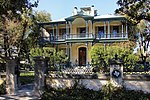Edward Steves Homestead

The Edward Steves Homestead is located in the Bexar County city of San Antonio in the U.S. state of Texas. It was designed by architect Alfred Giles and designated a Recorded Texas Historic Landmark. The main house was donated to the San Antonio Conservation Society in 1952. The organization completely restored the main house as a museum and now conducts daily tours. The complete homestead property consists of four individual structures: the main house museum, the carriage house, the river house, and the servants' quarters. It is listed on the National Register of Historic Places listings in Bexar County, Texas, as a contributing structure of the King William Historic District.
Excerpt from the Wikipedia article Edward Steves Homestead (License: CC BY-SA 3.0, Authors, Images).Edward Steves Homestead
King William Street, San Antonio
Geographical coordinates (GPS) Address Nearby Places Show on map
Geographical coordinates (GPS)
| Latitude | Longitude |
|---|---|
| N 29.412777777778 ° | E -98.495277777778 ° |
Address
Steves Homestead Museum
King William Street
78204 San Antonio
Texas, United States
Open on Google Maps






